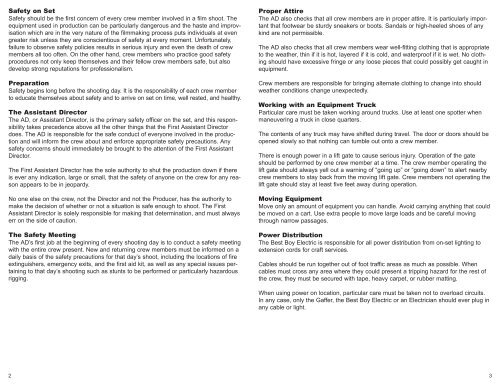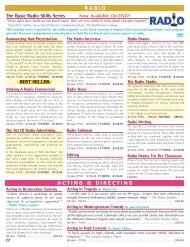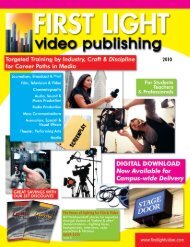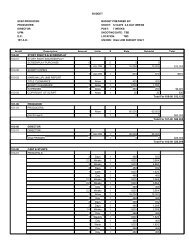to download Safety Manual & Checklist - First Light Video
to download Safety Manual & Checklist - First Light Video
to download Safety Manual & Checklist - First Light Video
You also want an ePaper? Increase the reach of your titles
YUMPU automatically turns print PDFs into web optimized ePapers that Google loves.
<strong>Safety</strong> on Set<br />
<strong>Safety</strong> should be the first concern of every crew member involved in a film shoot. The<br />
equipment used in production can be particularly dangerous and the haste and improvisation<br />
which are in the very nature of the filmmaking process puts individuals at even<br />
greater risk unless they are conscientious of safety at every moment. Unfortunately,<br />
failure <strong>to</strong> observe safety policies results in serious injury and even the death of crew<br />
members all <strong>to</strong>o often. On the other hand, crew members who practice good safety<br />
procedures not only keep themselves and their fellow crew members safe, but also<br />
develop strong reputations for professionalism.<br />
Preparation<br />
<strong>Safety</strong> begins long before the shooting day. It is the responsibility of each crew member<br />
<strong>to</strong> educate themselves about safety and <strong>to</strong> arrive on set on time, well rested, and healthy.<br />
The Assistant Direc<strong>to</strong>r<br />
The AD, or Assistant Direc<strong>to</strong>r, is the primary safety officer on the set, and this responsibility<br />
takes precedence above all the other things that the <strong>First</strong> Assistant Direc<strong>to</strong>r<br />
does. The AD is responsible for the safe conduct of everyone involved in the production<br />
and will inform the crew about and enforce appropriate safety precautions. Any<br />
safety concerns should immediately be brought <strong>to</strong> the attention of the <strong>First</strong> Assistant<br />
Direc<strong>to</strong>r.<br />
The <strong>First</strong> Assistant Direc<strong>to</strong>r has the sole authority <strong>to</strong> shut the production down if there<br />
is ever any indication, large or small, that the safety of anyone on the crew for any reason<br />
appears <strong>to</strong> be in jeopardy.<br />
No one else on the crew, not the Direc<strong>to</strong>r and not the Producer, has the authority <strong>to</strong><br />
make the decision of whether or not a situation is safe enough <strong>to</strong> shoot. The <strong>First</strong><br />
Assistant Direc<strong>to</strong>r is solely responsible for making that determination, and must always<br />
err on the side of caution.<br />
The <strong>Safety</strong> Meeting<br />
The AD’s first job at the beginning of every shooting day is <strong>to</strong> conduct a safety meeting<br />
with the entire crew present. New and returning crew members must be informed on a<br />
daily basis of the safety precautions for that day’s shoot, including the locations of fire<br />
extinguishers, emergency exits, and the first aid kit, as well as any special issues pertaining<br />
<strong>to</strong> that day’s shooting such as stunts <strong>to</strong> be performed or particularly hazardous<br />
rigging.<br />
2<br />
Proper Attire<br />
The AD also checks that all crew members are in proper attire. It is particularly important<br />
that footwear be sturdy sneakers or boots. Sandals or high-heeled shoes of any<br />
kind are not permissible.<br />
The AD also checks that all crew members wear well-fitting clothing that is appropriate<br />
<strong>to</strong> the weather, thin if it is hot, layered if it is cold, and waterproof if it is wet. No clothing<br />
should have excessive fringe or any loose pieces that could possibly get caught in<br />
equipment.<br />
Crew members are responsible for bringing alternate clothing <strong>to</strong> change in<strong>to</strong> should<br />
weather conditions change unexpectedly.<br />
Working with an Equipment Truck<br />
Particular care must be taken working around trucks. Use at least one spotter when<br />
maneuvering a truck in close quarters.<br />
The contents of any truck may have shifted during travel. The door or doors should be<br />
opened slowly so that nothing can tumble out on<strong>to</strong> a crew member.<br />
There is enough power in a lift gate <strong>to</strong> cause serious injury. Operation of the gate<br />
should be performed by one crew member at a time. The crew member operating the<br />
lift gate should always yell out a warning of “going up” or “going down” <strong>to</strong> alert nearby<br />
crew members <strong>to</strong> stay back from the moving lift gate. Crew members not operating the<br />
lift gate should stay at least five feet away during operation.<br />
Moving Equipment<br />
Move only an amount of equipment you can handle. Avoid carrying anything that could<br />
be moved on a cart. Use extra people <strong>to</strong> move large loads and be careful moving<br />
through narrow passages.<br />
Power Distribution<br />
The Best Boy Electric is responsible for all power distribution from on-set lighting <strong>to</strong><br />
extension cords for craft services.<br />
Cables should be run <strong>to</strong>gether out of foot traffic areas as much as possible. When<br />
cables must cross any area where they could present a tripping hazard for the rest of<br />
the crew, they must be secured with tape, heavy carpet, or rubber matting.<br />
When using power on location, particular care must be taken not <strong>to</strong> overload circuits.<br />
In any case, only the Gaffer, the Best Boy Electric or an Electrician should ever plug in<br />
any cable or light.<br />
3






